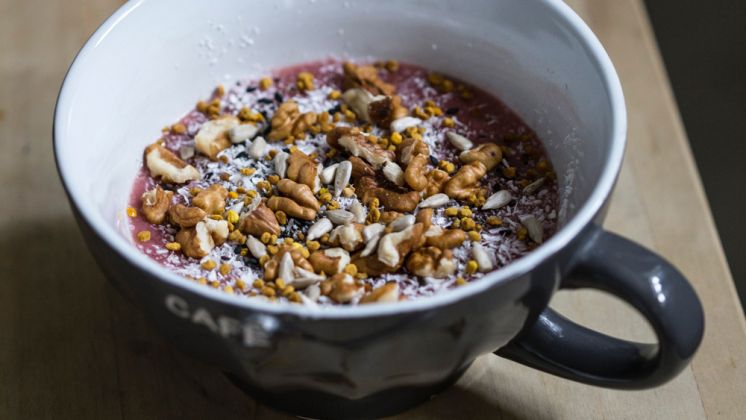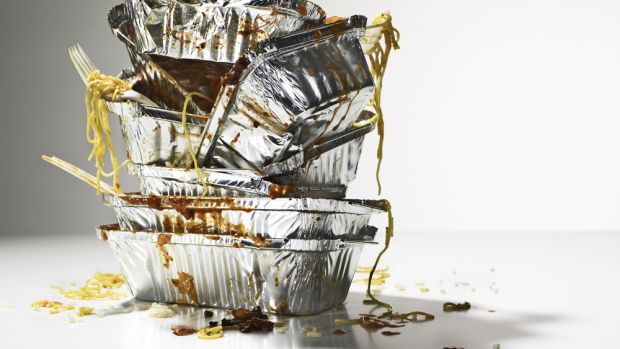Healthy Eating Made Simple
No more excuses. We’ve put your most common dietary problems to an elite panel of experts. Use their tips to eat better than ever

“A new type of thinking is essential if mankind is to survive and move toward higher levels,” Albert Einstein once said. And while he probably (OK, definitely) wasn’t talking about getting in shape, the man has a point.
If you’re still selling yourself down the nutritional river with ready-to-go excuses like “I just can’t cook” or “I don’t have time to eat better”, here’s where you stop, take a breath, look at the problem and think about it from a different angle.
To help, we’ve assembled a team of nutritionists, doctors and chefs who make their careers from helping people to eat better. Nobody has all the time they’d like, and not everyone likes kale, but there are always workarounds – and most of them start with a willingness to change… and to make a few mistakes along the way. In other words, don’t worry if you mess up a couple of pans. You can always get new pans.
The Problem: You’re Too Lazy To Make Healthy Food
OK, OK, not lazy – “differently motivated”. If that’s the problem, flip it around. “Think of this as your motivation: the alternative is to spend a lot of your time reading food labels, then trying to pick from the healthiest options available,” says nutritionist Rick Hay.
Not appealing? Time to scale it back: there are dozens of recipes that take minimal prep but still produce something delicious and healthy, without hours of julienning carrots and chiffonading kale. Start manageable, and use your small successes to build momentum.
Make soup with a kettle
No, not by pouring it in there, you savage. “This soup is super-easy,” says David Bez, who turned his relationship with food around in 2010 after challenging himself to make a different salad every day for a year. “Prepare an instant miso soup and add pastrami or smoked ham, watercress, pumpkin seeds and ribbon carrot. There’s no need to cook – you just need a kettle and a potato peeler for the carrot.” Protein, veg and healthy fats: sorted.
Know your bowls
“Smoothie bowls are an easy option for breakfast,” says Bez. “One of my favourites is just banana, lemon juice, turmeric powder, hemp protein and honey, topped with granola, yogurt and coconut flakes. It’s full of protein, flavour and antioxidants.” Get a spice rack, spend two minutes alphabetising it, and you’ll never again have to search for the turmeric.
Sign up for workout ideas, training advice, reviews of the latest gear and more.
Upgrade your brunch
Sure, pancakes are a hassle. But two-ingredient pancakes? Sensational. “Upgrade your weekend brunch by making a healthy alternative to traditional American breakfast pancakes,” says nutritionist Fiona Hunter. “Purée a banana and mix with two eggs for the batter. Cook them for a minute or two each side, then throw a few berries on top. Easy.”
RECOMMENDED: More Healthy Pancake Recipes
Eat toast… occasionally
Mornings a blur? You can still operate a toaster. “A strong coffee and a muffin won’t keep you going long but scrambled eggs on granary toast with a side of avocado will get you through the gym,” says Pilar Manzanaro, a nutritional therapist and founder of Purple Carrot Health Food Nutrition. “If you don’t have time to cook eggs in the morning, try nut butter on toast served with a few berries.” Save it for mornings when you’re training, and use those carbs as fuel.
…or just get a takeaway
“You can always order a healthy takeaway after a busy day,” says cardiologist and healthy diet campaigner Dr Aseem Malhotra. “Anything works as long as you’re avoiding sugar, refined carbs and anything cooked in industrial seed oils like corn or sunflower, which become toxic and pro-inflammatory at high temperatures. I insist my local Indian always cooks my food in butter or ghee. With Italian food, opt for the fish and vegetables cooked in extra virgin olive oil.’
The Problem: You Can’t Cook

It’s easily done: you spend your early 20s living on takeaways and beans on toast, then one day you realise you don’t know how to make soup. “You have to learn to cook,” says Malhotra. “It’s not just a useful skill – it’s ultimately going to make you healthier and happier. Poor diet in the form of processed and fast food now contributes globally to more disease and death than physical inactivity, smoking and alcohol combined.”
Fortunately, it’s fixable. Switch off the fancy cooking shows, ignore anything with more than five ingredients and focus on the basics: mastering heat, cooking meat, making veg taste better and getting the hang of a few simple taste combinations. After that you can graduate to experimenting with herbs and spices for more flavour – and health benefits.
Start with eggs
They’re loaded with 7g of protein – plus, if they’re free range, a healthy omega 3:6 ratio – and perfect any time of day. It’s worth mastering every format, but start with scrambled. “One simple tasty recipe is scrambled eggs with onion, tomatoes and fresh chillies,” says Malhotra. “Beat three free range organic eggs with half a chopped onion and a tomato, one green chilli, salt and pepper, and fry in 2tbsp of extra virgin coconut oil. Scramble with a spatula and cook until they start to set, then take them off the heat and stir until they’re done.”
RECOMMENDED: How To Cook The Perfect Omelette
Get better at steak
It’s very straightforward, and it lays the foundation for cooking other cuts of meat. “Rub it in oil, lightly salt both sides and get your pan very hot – give it at least three minutes on the heat before your meat goes in,” says chef Simon Rimmer. There are two schools of thought about cooking – either give it an equal amount of time on each side, or, for a crustier finish, flip it every 15 seconds – but either way, a 2cm-thick cut should take five or six minutes total.
RECOMMENDED: How To Cook Steak Like A Pro
Stir up your salads
“I’m pretty bad at cooking, which is why I started with salads,” says Bez, who turned his challenge into the book Salad Love. “They’re the easiest thing to make. Forget just leaves and use grains, veggies and proteins like beans, peas, eggs or cheese. I like to roast my veg in the oven – just chop them, add a drizzle of oil and salt and chuck them in the oven for half an hour. One favourite of mine is buckwheat, roasted squash, peas, thyme, red onion and a hard-boiled egg. For the dressing, mix 1tbsp extra virgin olive oil, 1tsp lemon juice, 1tsp mustard, 1tsp honey and a pinch of salt.”
Micro-steam veg
Steaming cooks your vegetables very lightly so you don’t turn them to mush or leech out their nutrients – and micro-steaming is the easiest way to make it fast. Just place a single layer of vegetables on a microwave-safe plate, cover them with a couple of damp paper towels and microwave them on full power until they’re tender enough to pierce with a fork. It should take between two and five minutes, depending on the power of your microwave.
Move up to marinades
The single simplest way to make food taste better. The basics are easy: leave your meat in a bowl or a sealed bag inside the fridge with a few carefully selected spices and some sort of liquid element, give it 30 minutes, then shake off the excess and fry, roast or grill as usual. With chicken, use harissa paste – which contains capsaicin for a mild fat-burning effect – and coconut oil. For Moroccan-style lamb, lime juice with turmeric and cinnamon stabilises your insulin levels and has anti-inflammatory benefits.
RECOMMENDED: Learn How To Cook Simple, Healthy Recipes With Chef Adam Grey
The Problem: You’re Too Busy To Eat Well

The motivation’s there, but the logistics aren’t quite working out. If you’ve got a 7pm finish and an hour’s commute – after the gym – you might be forgiven for throwing a ready-meal in the microwave when you finally get home.
“Cooking dinner at the end of a long day can be a bit of a chore,” admits Manzanaro. “So be more creative with when and how you make your food.”
Maximise the time you have. That might mean prepping at the weekends when you’ve got more time, or making plans in the morning to ensure you’ve got something to eat when you get home. It might be tricky initially, but once the habits are in place you’ll wonder how you got on without them.
Have an always-on smoothie plan
You can’t shop frequently enough to keep your kitchen bursting with fresh fruit – but there’s an easy fix. “Purée your favourite fruit and use an ice tray to create smoothie cubes,” says Hunter. “Then store them in the freezer, ready for when you need them. Blend the cubes with natural yogurt – job done.”
RECOMMENDED: Smoothie Recipes
Keep your snack game strong
“For healthier snack options, be careful of sugar and look for protein and good fats,” says Manzanaro. “Hummus and carrots, or nuts and yogurt work. A boiled egg and a few tomatoes is a far better option than a chocolate bar.” Chop some crudités on Sunday and store them in airtight containers for the week, using them for desk snacking or to stabilise your blood sugar before dinner.
RECOMMENDED: Low-Calorie Snacks
Make your own protein snacks
If polydextrose and gelatin hydroselate don’t sound appealing, it’s time to ditch the pre-made protein bars and roll your own. “Protein balls are a great portable snack – they can be made in bulk when you have time and stored in the freezer so they’re there when you need them,” says nutritional therapist Henrietta Norton, co-founder of Wild Nutrition. “They don’t require any cooking – you just mix the ingredients and then roll them into balls.” Mix ground almonds, desiccated coconut, protein powder, almond butter, coconut oil, lemon zest and vanilla extract – or experiment.
Take it slow
“Invest in a one-pot cooker,” says nutritional therapist Marjorie Green. “It preserves nutrients, and it’s an incredibly easy way to cook. You just chop a few ingredients and add them to the pot with seasoning, set it to the desired time and, if you use the slow cooker option, a delicious hot meal will be waiting for you when you get home.” Bonus: most of them cook flawless rice, too. For an easy chicken recipe, toss in thighs, soy sauce, ketchup and salt, then cook for six hours.
Re-use your pans
“Here’s a dinnertime hack: pan-cook your steak, remove from the pan to rest and while it’s resting use the same pan to stir-fry a few asparagus spears and mixed peppers,” says Manzanaro. “Add a minced garlic clove, a pinch of chilli, a dash of soy sauce and, some sesame seeds, and your dinner is ready in less than 15 minutes.”
The Problem: You’re In Love With Junk Food

Don’t be too hard on yourself for this one: teams of flavourologists are making good money keeping your typical binge fodder addictive. Apart from combining salt, sugar and fat – which have drug-like effects on dopamine receptors in your brain – your current favourite treat is precision-engineered to keep you coming back via superior texture, scent and mouthfeel. Not, unfortunately, something you can say for broccoli.
RECOMMENDED: Are You Hooked On Junk Food?
“Most modern junk foods and ready meals are not only laced with table salt and unhealthy trans fats, they also contain additives cunningly designed to turn you into a food junkie, so there has never been a better time to start preparing your food from scratch,” says Green. Your strategy should be twofold: kick the junk, then replace it with superior food choices.
Knock out your sweet tooth…
“To beat the sugar addiction cycle, first go cold turkey for two weeks,” says Malhotra. “That means no food with added sugar, no honey, fruit juice or syrups. After that the cravings start to disappear and your taste buds adjust so you notice sweetness in foods more easily. I enjoy a square of dark chocolate – aim for 85% cocoa solids or higher – with my morning coffee every day but you can have it for dessert if you prefer.” It may not be easy, but there are ways to make it easier…
…with a bit of preparation
“Sugar addiction is a challenging one to overcome,” admits Norton. “The only way to approach it is to always be prepared – have a sugar-free snack to hand and try to take measures to avoid becoming over-tired and over-hungry. If you’re an emotional eater, try to avoid situations that trigger you and make you want to overeat sugary foods. Protein and healthy fats are your friend when you are trying to reduce your sugar intake. Eventually the junk food and snacks that you used to love will taste excessively sweet and you will enjoy them less.”
Get rid of your cues
A study from Duke University in the US suggests that you “outsource” activities to your environment: so sitting in your favourite spot on the couch might make you want a beer, while taking your normal route to work could be tempting you to have an almond croissant. Disrupt the pattern by changing your chair or your route, and it’ll be easier to kick the habit.
Rewire your brain
Charles Duhigg, author of The Power Of Habit, offers this solution to habitual office-snackers: instead of trying to ignore the habit entirely, look at the reason for it and find a new, better behaviour that fulfils the same need. For instance, if you always hit the vending machine at 11am, is it really for a desk break, an energy boost or because you’re thirsty? If so, take a quick stroll to a colleague’s desk, eat an apple, or glug a sparkling water – respectively.
And don’t say “can’t”
When the bad stuff comes up – at a cake sale, drive-thru or after-work drinks – “I can’t” makes it seem like you’re depriving yourself. Saying “I don’t” instead – “I don’t drink on weeknights” - signifies determination and, according to the Journal Of Consumer Research, it’s more likely to work.
From 2008 to 2018, Joel worked for Men's Fitness, which predated, and then shared a website with, Coach. Though he spent years running the hills of Bath, he’s since ditched his trainers for a succession of Converse high-tops, since they’re better suited to his love of pulling vans, lifting cars, and hefting logs in a succession of strongman competitions.

